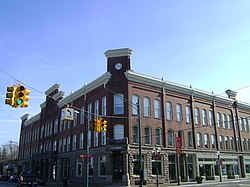
Mecosta County is a county located in the U.S. state of Michigan. As of the 2020 Census, the population was 39,714. The county seat is Big Rapids.

Kent County is located in the U.S. state of Michigan. As of the 2020 Census, the county had a population of 657,974, making it the fourth most populous county in Michigan, and the largest outside of the Detroit area. Its county seat is Grand Rapids. The county was set off in 1831, and organized in 1836. It is named for New York jurist and legal scholar James Kent, who represented the Michigan Territory in its dispute with Ohio over the Toledo Strip.

M-1, commonly known as Woodward Avenue, is a north–south state trunkline highway in the Metro Detroit area of the US state of Michigan. The highway, called "Detroit's Main Street", runs from Detroit north-northwesterly to Pontiac. It is one of the five principal avenues of Detroit, along with Michigan, Grand River, Gratiot, and Jefferson avenues. These streets were platted in 1805 by Judge Augustus B. Woodward, namesake to Woodward Avenue. The Federal Highway Administration (FHWA) has listed the highway as the Automotive Heritage Trail, an All-American Road in the National Scenic Byways Program. It has also been designated a Pure Michigan Byway by the Michigan Department of Transportation (MDOT), and was also included in the MotorCities National Heritage Area designated by the US Congress in 1998.

The Clinton Valley Center (CVC), originally called the Eastern Michigan Asylum for the Insane, was a psychiatric hospital located at 140 Elizabeth Lake Road in Pontiac, Michigan. The facility was designated a Michigan State Historic Site in 1974 and listed on the National Register of Historic Places in 1981, with a decrease in its boundaries in 1986. The facility was closed in 1997 and demolished in 2000.
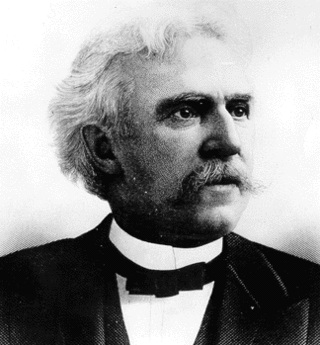
Elijah E. Myers was a leading architect of government buildings in the latter half of the 19th century, and the only architect to design the capitol buildings of three U.S. states, the Michigan State Capitol, the Texas State Capitol, and the Colorado State Capitol. He also designed buildings in Mexico and Brazil. Myers' designs favored Victorian Gothic and Neo-Classical styles, but he worked in other styles as well.

Jackson station is a historic Amtrak station in Jackson, Michigan, United States. It is served by three daily Wolverine trains between Chicago and Pontiac and a single daily Amtrak Thruway bus between Toledo, Detroit, Jackson, and East Lansing. The station was added to the National Register of Historic Places in 2002.

The Masonic Temple in Cadillac, Michigan is a commercial building built in 1899. It is the earliest surviving fraternal building designed by the prolific architect Sidney Osgood. It was listed on the National Register of Historic Places in 1994.
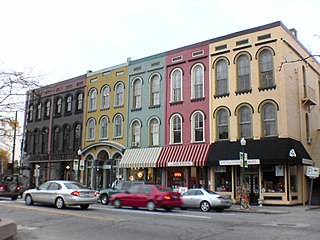
The Ypsilanti Historic District is a historic district located along several blocks on each side of the Huron River in the center of Ypsilanti, Michigan. The original portion of the district was designated a Michigan State Historic Site in 1973 and listed on the National Register of Historic Places in 1978; additions to the district were nationally listed in 1989.

The Chelsea Commercial Historic District is a historic district located along both sides of Main Street from Orchard to North Street in Chelsea, Michigan; the district also includes the adjacent 100 blocks of Jackson, East Middle, and West Middle Streets, as well as structures on Park, East, and Orchard Streets. It was listed on the National Register of Historic Places in 2011.

The Goodyear Block, also known as the Arbeiter Block is a commercial building located at 138 E. Main Street in Manchester, Michigan. It was listed on the National Register of Historic Places in 1993.
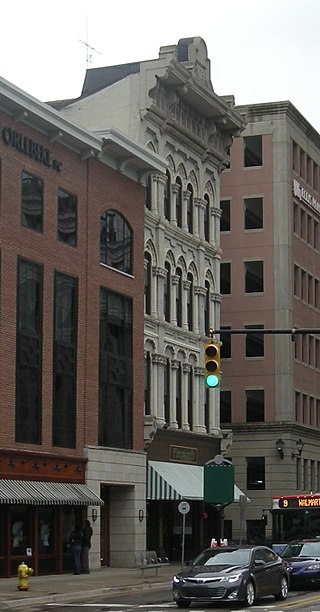
The Rood Building is a commercial building in Grand Rapids, Michigan, listed on the National Register of Historic Places. It was built in 1873 for Charles Conant Rood, after whom the building is named.
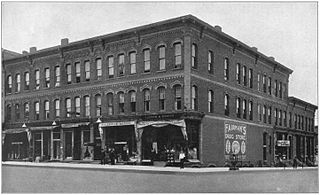
The Fairman Building is a commercial building located at 102-106 South Michigan Avenue in Big Rapids, Michigan. It was listed on the National Register of Historic Places in 1987.

The Cobbs and Mitchell Building is an office building located at 100 East Chapin Street in Cadillac, Michigan. It was designated a Michigan State Historic Site in 1980. and listed on the National Register of Historic Places in 2010.

The Old Cadillac City Hall is a government building located at 201 Mitchell Street in Cadillac, Michigan. It was designated a Michigan State Historic Site in 1983 and listed on the National Register of Historic Places in 1986.

Marshall's Store, also known as DeHaven's Store, or the Marshall/DeHaven Store, is a commercial building located at 102 East St. Joseph Street in Lawrence, Michigan. It was designated a Michigan State Historic Site in 1979 and listed on the National Register of Historic Places in 2002.

The Gratiot County Courthouse is a government building located at 214 East Center Street in Ithaca, Michigan. It was designated a Michigan State Historic Site in 1957 and listed on the National Register of Historic Places in 1976.

Waterford Village is an historic community in Waterford Township, Michigan. First settled in 1819, the village is located in the northernmost part of the township along Dixie Highway, on the southeast shore of Van Norman Lake.

The Michigan Trust Company Building, also known as the Michigan Trust Building or just the Trust Building, is an office building located at 40 Pearl Street NW in Grand Rapids, Michigan. It was listed on the National Register of Historic Places in 1983.

The Peck Block is a commercial building located at 34-50 Monroe Center NW in Grand Rapids, Michigan. It was listed on the National Register of Historic Places in 2000. The building has been rehabilitated to house condos on the upper floors.
